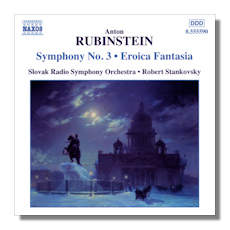
The Internet's Premier Classical Music Source
Related Links
- Rubinstein Reviews
- Latest Reviews
- More Reviews
-
By Composer
-
Collections
DVD & Blu-ray
Books
Concert Reviews
Articles/Interviews
Software
Audio
Search Amazon
Recommended Links
Site News
 CD Review
CD Review
Anton Rubinstein

- Symphony #2 in C Major, Op. 42, "Ocean"
Slovak Philharmonic Orchestra/Stephen Gunzenhauser
Naxos 8.555392


- Symphony #3 in A Major, Op. 56
- Eroica Fantasia, Op. 110
Slovak Radio Symphony Orchestra/Robert Stankovsky
Naxos 8.555590
Rubinstein's Second Symphony, the "Ocean", dates to 1851, when it was much shorter and not yet tagged with its nickname. The composer revised the work in 1863, adding two movements and generally enlarging the whole, and giving it its moniker, apparently not noticing the incongruity that his 'Ocean' Symphony, in its six movements, was symbolically at odds with the number of oceans in the world. He then added yet another movement in 1880 to rectify the omission, pushing his symphony to Brucknerian lengths – on this recording the timing is 72:56. The result is a controversial work, full of moments of great beauty, but undoubtedly in need of some trimming.
Stephen Gunzenhauser, in this 1986 effort (originally released on Marco Polo in 1987), is well attuned to Rubinstein's idiom and conducts each movement with insight and an ear for detail. Some critics have charged he is too slow in the eighteen-minute Lento assai second movement, but I think the overlong feeling here is more a fault of Rubinstein than of Gunzenhauser and his tempo selections. Certainly, his central Allegro sparkles and nothing else ever really drags. And if the playing by the Slovak Philharmonic Orchestra isn't first-rate, it's at least quite decent, and the sound is acceptable, if a bit rough. The crucial point here is, there is currently only one other recording in competition with this one that isn't any better – a more expensive Russian Disc issue led by Ivan Golovchin. For those interested in Rubinstein's music, this Naxos disc will do.
The Third Symphony here fares better and would probably bring a recommendation, even if it had significant competition. Its four movements offer about twenty-five minutes less music than the gargantuan Second, but more importantly amount to a better composition. Moreover, conductor Robert Stankovsky is somewhat more incisive and compelling in his phrasing, tempo selections and capturing of detail. The Third is one of Rubinstein's more modest symphonic creations: it's content to cover just one world or 'ocean' with its largely upbeat music.
Again, as in much of Rubinstein's orchestral music – especially the First Symphony – the voice of Mendelssohn can be noticed. The second movement, for instance, delightfully shows that influence, but not in an overwhelming or imitative fashion. The sound is better here than on the Second, and is overall quite good. Clearly, if I had to choose a recording of a Rubinstein Symphony, this would have to be the one, at least until Naxos reissues the Fifth Symphony, which may well be the composer's orchestral masterpiece.
The filler here is a quite substantial one, the nearly-half-hour Eroica Fantasia, a lesser work, but one not without its moments of joy and beauty. Stankovsky and his Slovak players turn in a fine account of it, as well, making this release even more attractive.
Copyright © 2002, Robert Cummings


















